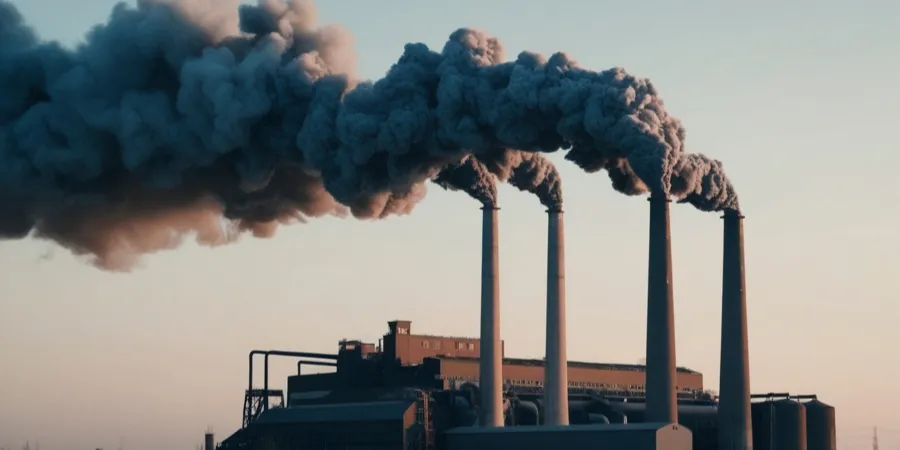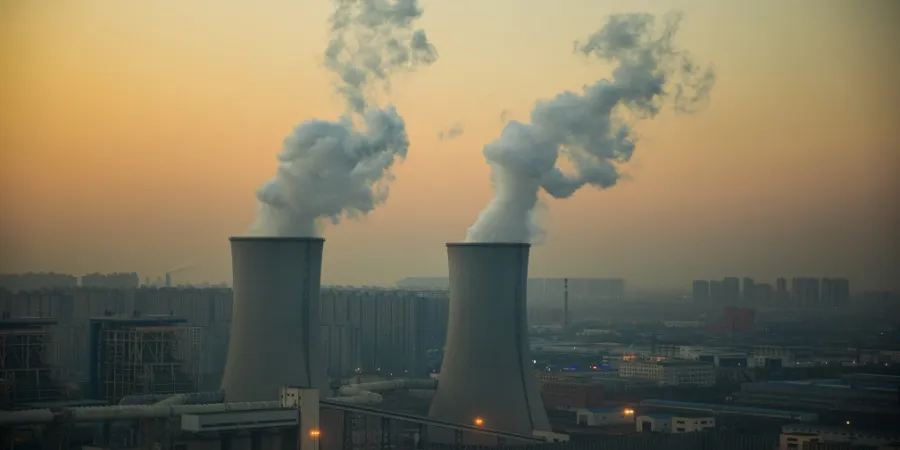In industry and laboratories, workers are often exposed to organic vapors, inorganic gases, acidic vapors and ammonia compounds, which are extremely hazardous to health.
ABEK gas masks are therefore widely used in the chemical, mining, agricultural, and environmental fields. In this article, we will introduce the key role of activated carbon in the ABEK gas mask to help you choose the right activated carbon product.
What is an ABEK Gas Mask?

An ABEK gas mask is a type of respiratory protective equipment designed to protect against multiple hazardous gases and vapors. The term “ABEK” represents the filter’s protective range. According to European Standard EN 14387, the ABEK filter covers:
- Type A: Organic gases and vapors (e.g., solvents, benzene compounds)
- Type B: Inorganic gases (e.g., chlorine gas, hydrogen sulfide H₂S)
- Type E: Acidic gases (e.g., sulfur dioxide SO₂, hydrogen chloride HCl)
- Type K: Ammonia and its derivatives (e.g., NH₃)
This gas mask typically consists of a facepiece and an ABEK filter cartridge, which effectively removes harmful components from the air. It is widely used in chemical, pharmaceutical, painting, environmental management, and emergency rescue applications to ensure respiratory safety.
The Role of Activated Carbon in ABEK Gas Mask
Activated carbon is a specially treated porous carbon material with an extremely high surface area and excellent adsorption capacity. It plays a vital role in ABEK gas mask, providing protection against the following toxic substances:
- Organic vapors (A): such as solvents, benzene, and toluene.
- Inorganic gases (B): such as chlorine and hydrogen sulfide.
- Acidic gases (E): such as sulfur dioxide.
- Ammonia and derivatives (K): such as anhydrous ammonia.
The filtration mechanism of activated carbon relies primarily on adsorption, a physical process in which gas molecules are trapped on the surface of activated carbon. This efficiency comes from its intricate network of micropores and macropores, capable of capturing even the smallest toxic molecules.
To enhance selectivity, activated carbon is often impregnated with special chemical agents. For example:
- Alkaline salts significantly improve adsorption of acidic gases such as SO₂ and HCl;
- Metal salts enable efficient removal of ammonia and its organic derivatives;
- Adjusting pore size distribution and surface functional groups further optimizes adsorption of organic vapors and inorganic gases.
By combining physical adsorption with chemical reactions, ABEK filter cartridges maintain high efficiency and stability even in complex environments.
Contact me todayApplications for ABEK Gas Masks
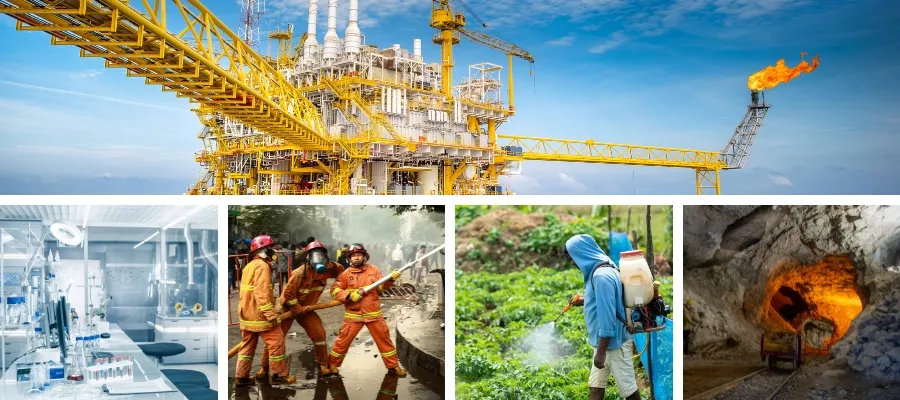
Thanks to their excellent filtration performance, ABEK gas masks are widely used in various fields, particularly in environments requiring effective protection against toxic gases and vapors. Key application areas include:
Industrial Manufacturing
Workers in industrial manufacturing are often exposed to large amounts of harmful gases, including organic solvents, acidic vapors, and inorganic gases. ABEK gas masks provide essential protection. Common scenarios include:
- Chemical plants: Protection against chlorine, hydrogen sulfide, and other toxic gases.
- Painting and coating workshops: Adsorption of organic solvent vapors such as benzene and toluene.
- Metallurgy and mining: Protection against sulfide or ammonia leaks.
Medical and Laboratory Use
Medical staff and researchers may encounter toxic chemicals and gases. ABEK gas masks ensure safety in confined workspaces, for example:
- Laboratory research: Protection against harmful vapors released from chemical reagents.
- Medical disinfection: Adsorption of ozone and other vapors generated during disinfection processes.
Emergency Response and Firefighting
Rescue teams often face toxic gas leaks or chemical smoke during emergencies. ABEK gas masks are crucial protective equipment:
- Chemical spill accidents: Protection against ammonia, hydrogen sulfide, and other hazardous gases.
- Fire rescue: Adsorption of carbon monoxide, sulfur dioxide, and toxic fumes.
Oil and Gas Industry
In oil and gas operations, the risk of toxic gas leakage is common. ABEK gas masks protect workers from methane, hydrogen sulfide, and other hazardous gases, ensuring operational safety.
Agriculture and Food Processing
In agriculture and food processing, workers may be exposed to harmful substances such as ammonia or pesticide vapors. ABEK gas masks effectively adsorb these gases to protect health.
Contact me todayTypes of Activated Carbon for ABEK Gas Mask
Selecting the right activated carbon is key to ensuring optimal ABEK protection. TingyuanCarbon offers various types of activated carbon to meet different filtration needs.
Coconut Shell Activated Carbon
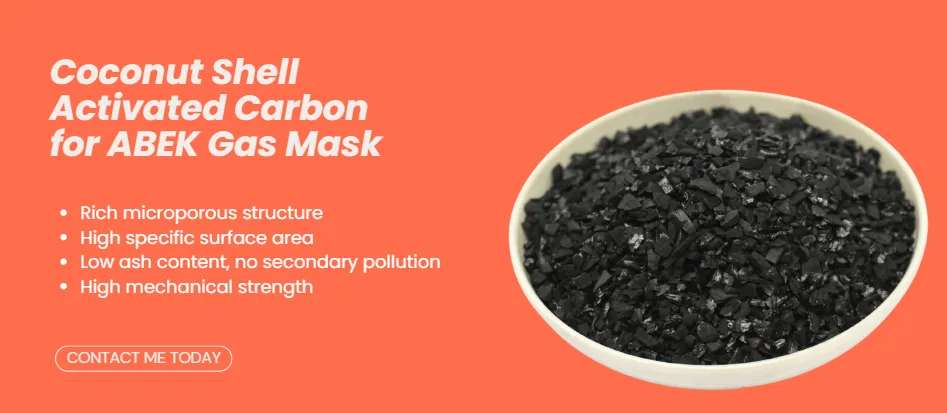
We provide high-performance coconut shell activated carbon with an abundance of micropores and a high surface area. These micropores are especially effective for adsorbing low molecular weight organic vapors such as benzene, toluene, acetone, and other solvent vapors.
In the ABEK gas mask, coconut shell granular activated carbon primarily serves the type A filtration function, efficiently removing organic pollutants from the air.
Coal-Based Activated Carbon
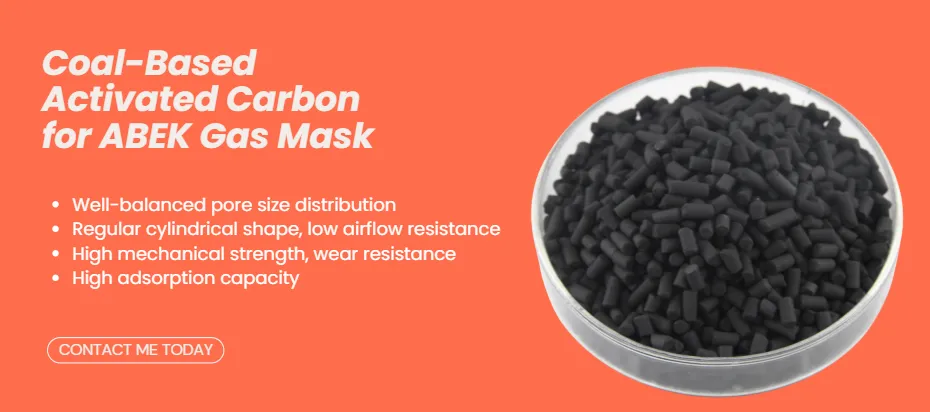
Produced from high-quality bituminous coal or anthracite, this activated carbon is uniform in shape, mechanically strong, and offers low airflow resistance. Its durability and resistance to abrasion make it ideal for long-term respirator use without risk of dusting or clogging.
With a more balanced pore size distribution, coal-based activated carbon excels at adsorbing inorganic gases and acidic gases such as chlorine, hydrogen sulfide, and sulfur dioxide. In ABEK gas mask, it is typically used for type B and type E filtration.
Impregnated Activated Carbon
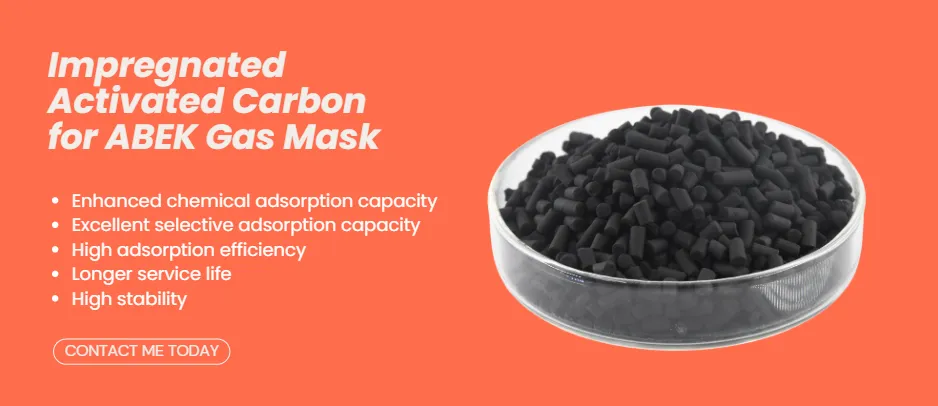
Impregnated activated carbon is modified by loading chemical agents (e.g., alkaline salts, metal salts, or oxidizers) onto the carbon surface, enhancing its selective adsorption and chemical reactivity toward specific gases. For example:
- Alkaline salt impregnation enhances removal of acidic gases (SO₂, HCl).
- Copper and silver salt impregnation strengthens removal of ammonia (NH₃) and amines.
- Specific metal oxides further improve fixation of hydrogen sulfide and similar toxic gases.
Thus, impregnated activated carbon is essential for type E and type K protection in ABEK filters, ensuring multi-functional defense.
At TingyuanCarbon, we are committed to providing high-performance activated carbon solutions for the ABEK gas mask. With over 20 years of industry experience, we maintain international standards in raw material selection, production processes, and quality control to ensure product reliability and stability under complex working conditions.
Contact me todayConclusion
Activated carbon is the core material in ABEK respirators. Thanks to its exceptional adsorption performance, it provides superior protection in industrial-grade filters. At TingyuanCarbon, we are dedicated to delivering high-quality activated carbon solutions. Contact us today to ask for free samples and customized solutions.


